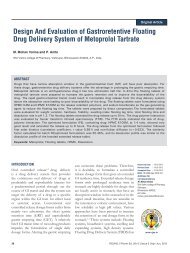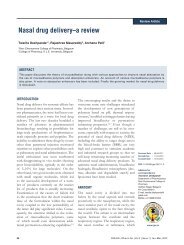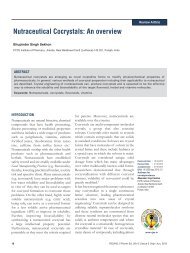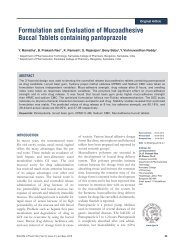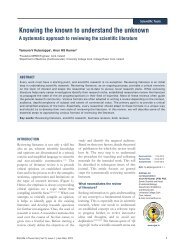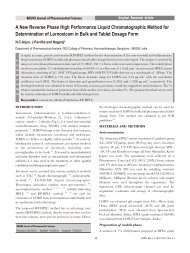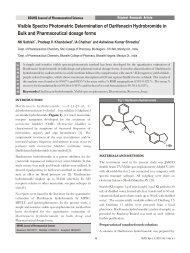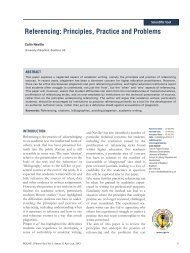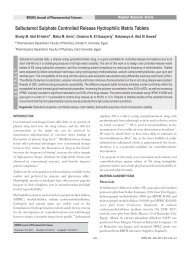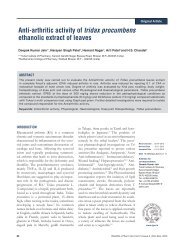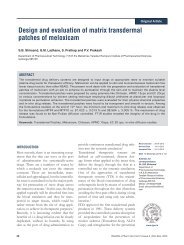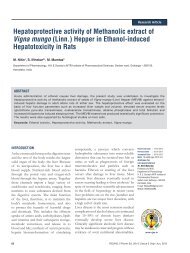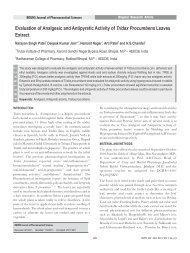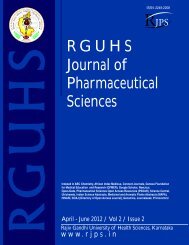Chitosan Loaded Mucoadhesive Microspheres of Gliclazide - Journal
Chitosan Loaded Mucoadhesive Microspheres of Gliclazide - Journal
Chitosan Loaded Mucoadhesive Microspheres of Gliclazide - Journal
You also want an ePaper? Increase the reach of your titles
YUMPU automatically turns print PDFs into web optimized ePapers that Google loves.
RGUHS <strong>Journal</strong> <strong>of</strong> Pharmaceutical Sciences<br />
Assessment <strong>of</strong> Safety and Efficacy <strong>of</strong> Doxycycline and Azithromycin<br />
Preparations in Patients with Acne Vulgaris<br />
1<br />
Mahendra Kumar B.J*, Ramakrishna S , Kranti Basavant Patil, Sandeep A, Bhimaray S Krishnagoudar and<br />
Katti Ravi Venkappa.<br />
A B S T R A C T<br />
Clinical Pharmacy Department, S A C College <strong>of</strong> Pharmacy, B.G.Nagara-571448, Karnataka<br />
1 Principal, CR College <strong>of</strong> Pharmacy, Koratagere, Tumkur, Karnataka<br />
INTRODUCTION<br />
Acne vulgaris is a chronic inflammatory dermatosis which is<br />
notable for open and/ or closed comedones (blackheads and<br />
whiteheads) and inflammatory lesions including papules,<br />
1<br />
pustules, or nodules. Acne vulgaris is the most common skin<br />
disorder in the United States, affecting 40 to 50 million<br />
people. Acne vulgaris affects approximately about 80% <strong>of</strong> the<br />
total population between the age <strong>of</strong> 12 to 25 years, with no<br />
gender, race, or ethnicity prevalence. Acne depending on the<br />
ages varies and usually begins at puberty. A form <strong>of</strong> acne<br />
called adult acne may first occur after the mid 20s, affecting<br />
females more than males, and with lesions generally<br />
distributed in the lower facial area around the mouth, chin<br />
2<br />
and jaw line.<br />
Localization <strong>of</strong> acne vulgaris on the facial area, especially in<br />
adolescent population, significantly impacts self-esteem.<br />
Although acne is self limiting, it can persist for years and can<br />
result in disfigurement and scarring. Acne may also be<br />
associated with anxiety, depression, and higher than average<br />
unemployment rates. As the emotional impact <strong>of</strong> acne is not<br />
always easy to assess clinically, it is important for the health<br />
care pr<strong>of</strong>essionals to educate patients on various causes <strong>of</strong><br />
acne, discussing treatment regimens, and counseling on<br />
2<br />
proper medication use.<br />
RGUHS <strong>Journal</strong> <strong>of</strong> Pharmaceutical Sciences<br />
Received: 27/1/2011, Modified: 27/2/2011, Accepted: 4/3/2011<br />
131<br />
Original Research Article<br />
Acne vulgaris is the most common skin disease, affects 80% <strong>of</strong> population between the age <strong>of</strong> 12 and 25 years with no gender, race or<br />
ethnicity prevalence. Oral and topical agents advocated for the treatment. Antibiotics are the mainstay <strong>of</strong> acne treatment. The objective<br />
<strong>of</strong> the study is to assess efficacy and safety <strong>of</strong> azithromycin and doxycycline with topical clindamycin for patients with acne vulgaris. This<br />
study is a prospective, observational, investigational and randomisation study carried out in Dermatology department <strong>of</strong> a tertiary care<br />
teaching hospital in a north Karnataka for a period <strong>of</strong> 8 months. Patients enrolled in the study were divided in to two groups- Group-I and<br />
Group-II. The Group-I received Tablet Azithromycin 500 mg with Topical Clindamycin where Group-II received Tablet Doxycycline 100<br />
mg with Topical Clindamycin. Clinical assessment was done at 30 days interval for 3 months. The mean severity index <strong>of</strong> Group-I<br />
rd<br />
declined from 113.36 to 09.92 at 3 follow-up and Group-II from 107.32 to 28. In Group-I out <strong>of</strong> 25 patients 2 patients reported ADR where<br />
from Group-II out <strong>of</strong> 25 patients 6 patients reported ADR.<br />
Keywords: Acne vulgaris, Azithromycin, Doxycycline, efficacy and safety assessment.<br />
Antibiotics are a main stay <strong>of</strong> acne treatment, and<br />
clindamycin phosphate is the most widely used topical<br />
antibacterial agent. Although there are several effective<br />
therapies for acne vulgaris, lack <strong>of</strong> adherence to the treatment<br />
regimen is believed to contribute to treatment failure or less<br />
3<br />
than optimal result.<br />
There are number <strong>of</strong> oral antibiotics that are used to treat<br />
acne including minocycline, tetracycline, and doxycycline.<br />
The efficacy and possible side effects <strong>of</strong> these various oral<br />
antibiotics has been the subject <strong>of</strong> numerous studies for at<br />
least the last 20 years in an effort to understand, which<br />
products are likely to produce better results with the least<br />
4<br />
amount <strong>of</strong> possible side effects.<br />
While effective therapeutic options exist for the treatment <strong>of</strong><br />
acne, treatment compliance with acne medications has been<br />
shown to be as low as 12.5%. In fact poor patient compliance<br />
has been identified as the main reason for acne treatment<br />
failure. Accurate diagnosis, appropriate therapy and good<br />
compliance with directions for therapy are all important<br />
5<br />
components in the treatment <strong>of</strong> disease.<br />
Antibiotics used for the treatment <strong>of</strong> acne vulgaris are<br />
associated with some <strong>of</strong> the mild to severe side effects and<br />
require interventional studies to compare the efficacy and<br />
safety pr<strong>of</strong>iles <strong>of</strong> these medications to ensure the safe usage <strong>of</strong><br />
medications. Therefore, this study is being conducted to assess<br />
the efficacy and safety <strong>of</strong> azithromycin and doxycycline with<br />
topical clindamycin for patients with acne vulgaris.<br />
RJPS, Jul - Sep, 2011/ Vol 1/ Issue 2



